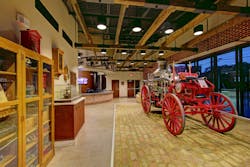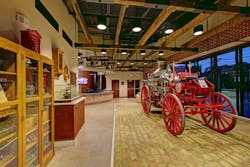Every fire department has history, and that history can be documented and honored in various ways: large or small museums or less official dedicated space; as few as one or as many as dozens of historical items, whether that be equipment or statues, turnout gear or photographs, bells and alarms or memorials. This all might be obvious to those who are involved in the planning for a new or refurbished firehouse or other department building. What might escape many people is the value of going outside of the department for any ideas or information.
“Building projects that contain a museum or specific historical emphasis often can benefit from the input and collaboration with additional groups, such as historical societies and architectural review boards, during the design process,” Ken Newell of Stewart-Cooper-Newell Architects tells Firehouse Magazine.
For an example, Newell points to the city of Danville, VA, and its plans for a new fire headquarters. The city selected a site that formerly was occupied by the Danville Lumber Company in the historic Tobacco Warehouse District. Multiple city departments were involved in the project, but the most impactful interaction was with three advising historical groups: the Danville Historical Society, Preservation Virginia and the Virginia Historical Society. They stressed the importance of a project that integrated reclaimed building materials, to convey the historical site features and complement the fabric of the landscape.
LeMay Erickson Willcox Architects was instrumental in the reuse of salvaged decorative tiles, the likes of which went out of production long ago. The firm’s design preserved the central open stairway to the bays, including the terrazzo floors. Marble slabs from the showers were repurposed for use in the restroom areas
“We also revitalized several old skylights and lightwells,” LeMay Erickson Willcox Architects’ Paul Erickson says.
When the project was completed, firefighters installed many historic artifacts throughout the building. Among them: the original “hotline phone” that was linked to The White House. (Engine Co. 16 is first due to The White House.) Display cases in renovated lobbies display the call logs from the station’s more than 80 years of service.
“I’ve been told that these call logs have brought some older members to tears when they have visited the renovated station,” Erickson points out. “While the building doesn’t have a designated area for display [of artifacts], it is an embodiment of historic preservation and respect for the past.”
A Texas trio
Justin Myers of Martinez Architects tells Firehouse Magazine that all of the planning that was required for a new administration building for Aldine, TX, Fire & Rescue involved Fire Chief Dave Parker’s desire to present the department’s history in a way that had been discussed at length for years by longtime department members and long-term commissioners.
“The intent is to showcase the origin of the department and how it evolved to maintain its legacy for the community and future firefighters,” Parker explains.
Among options considered during design: a bay in the station for antique apparatus.
Although cost and budgetary needs were important, the opportunity to provide an educational resource was a priority consideration. A delicate balance that considered costs versus what makes something worthy of preserving had to be struck.
Another question that was raised during the planning for the Aldine Fire & Rescue administration building: Who was going to maintain, curate and/or drive around an antique truck? Would those responsibilities fall on the administration or on the fire service staff?
The McKinney, TX, Fire Department and Fire Chief Danny Kistner wanted to apply a different approach than the conventional to incorporating the department’s past, present and future into a new fire department headquarters building.
“In the past, the department had a lot of photographs and memorabilia on the walls in the fire department administration area, but it was mostly 1920s black-and-white pictures, not what firefighters want to see. They want to see photographs of themselves,” Kistner says. “I want them to see a reflection of themselves and for the public to see what we’re doing” for them.
Among the innovations that were specified: a building column that’s wrapped with images. Also, digital frames that run a slideshow of photographs of various subjects make updates easier.
The McKinney Fire Department has a dedicated museum at Fire Station 1, with an antique truck, equipment and historical records, so the new station/headquarters contrasts with Fire Station 1.
When the Midland, TX, Fire Department began planning to replace the existing Station #5, Fire Chief Charles Blumenauer says the planning committee wanted to do something for the local community, given that those people were going to lose their beloved old station. “At the same time, we wanted to avoid wasting space, so we chose to utilize the stairwell space for history preservation,” Blumenauer explains.
The plaque that commemorated the dedication of the original station in 1958 was preserved and placed in the stairwell of the new firehouse. A vibrant wall mural was commissioned to be painted on a wall that’s located opposite of a platform that will be used for the display of department historical artifacts.
Tangible appreciation
The Summit, NJ, Fire Department is taking advantage of the construction of a new headquarters to incorporate a fire prevention education area/department museum.
“There is an adjacent mezzanine that overlooks the antique fire truck, where groups can meet with the fire prevention team to learn about the importance of fire safety and about the history of their city’s fire department,” Christopher Kehde of LeMay Erickson Willcox Architects explains in regard to the site plans.
Newell sums up the topics of preserving fire department history: “Memorials mean many things to many people, and one often over-looked aspect is encouragement to the active firefighters.” Memorials, he makes a specific point to add, are a tangible appreciation of those who are willing to risk their life to protect others who are in the community. “It is a daily reminder within the station environment that is crucial to the community and that the community will never forget those who sacrificed everything in the performance of the profession.”
From Guinness to Ghosts
Manistee, MI, Fire Department’s building was constructed in 1888 after a forest fire destroyed the original station. In 2017, Manistee Training Officer/Driver-Engineer/EMT Fred LaPoint’s interest in history prompted him to research the department’s old fire station and to submit the results of his project to Guinness World Records. In fact, according to Guinness, the 130-year-old Manistee Fire Department is the world’s oldest continuously manned operation fire station in the world.
Other fire stations that are considered to be among the oldest are the Louisville, KY, Fire Department’s Fire Station No. 7, which was built in 1871 (closed in 2009); the Los Angeles Fire Department’s Plaza Fire House, which operated from 1884 to 1897; and Detroit Fire Department’s Engine Company #11, which was built in 1884.
The Denver Fire Department’s Fire Station No. 1 & No. 3 has the reputation of being the most haunted firehouse in the United States. Now a fire museum and restaurant, the firehouse’s “paranormal activities” draw tourists, including ghost hunters.
About the Author
Janet A. Wilmoth
Special Projects Director
Janet Wilmoth grew up in a family of firefighters in a suburb of Chicago. Wilmoth, who is owner of Wilmoth Associates, worked with Fire Chief magazine for 27 years until it closed in 2013. She currently is the project director for Firehouse, overseeing the Station Design Conference.


